And a very happy Free For All birthday to Sadegh Hedayat, Iranian author, poet, and intellectual, who was born this day in 1903.

Hedayat was raised in an aristocratic family with many ties to the French imperial government and, as a result, was sent to Europe to receive a “western” education at a fairly early age. Initially, he planned to become an engineer, but after falling in love with the architecture of Paris, Hedayat decided to become an architect…and later a dentist….in the end, he returned to Iran without a degree, and held a number of jobs while devoting his life to studying Iranian history, prose, folktales, and myths.
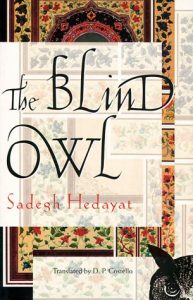 He produced a considerable body of work, including short stories, poems, travel pieces, and literary criticism, all of which attempted to move Iranian literature into the ‘modern’ world. At the same time, he began heavily criticizing what he perceived to be the two major causes of Iran’s decimation: the monarchy and the clergy, and through his stories he tried to impute the deafness and blindness of the nation to the abuses of these two major powers. His most well-known work, The Blind Owl, is a startling piece of modernism that confronts human beings’ inherent lack of ‘civilization’, while also confronting head-on the anguish of living under repression. The book was originally published with a stamp that read “Not for sale or publication in Iran.”, but was serialized there after the abdication of Reza Shah in 1941. Sadegh Hedayat committed suicide in Paris in 1951, leaving behind a body of work that is still striking today for its insights and its impact, and a legacy of being the first modernist in Iranian literature.
He produced a considerable body of work, including short stories, poems, travel pieces, and literary criticism, all of which attempted to move Iranian literature into the ‘modern’ world. At the same time, he began heavily criticizing what he perceived to be the two major causes of Iran’s decimation: the monarchy and the clergy, and through his stories he tried to impute the deafness and blindness of the nation to the abuses of these two major powers. His most well-known work, The Blind Owl, is a startling piece of modernism that confronts human beings’ inherent lack of ‘civilization’, while also confronting head-on the anguish of living under repression. The book was originally published with a stamp that read “Not for sale or publication in Iran.”, but was serialized there after the abdication of Reza Shah in 1941. Sadegh Hedayat committed suicide in Paris in 1951, leaving behind a body of work that is still striking today for its insights and its impact, and a legacy of being the first modernist in Iranian literature.
And speaking of literature….here are some of the books that trudged through this week’s snow to make it onto our shelves this week!

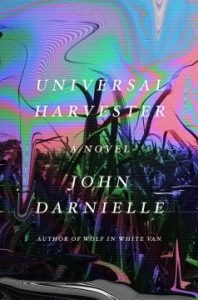 Universal Harvester: If the holographic cover on this creepy little tome doesn’t catch your eye, then I certainly hope the blurb will. John Darnielle takes the current literary love of nostalgia and turns it into something dark, disquieting, and subtly spellbinding. The story is set in the late 1990’s in the tiny town of Nevada, Iowa, where very little ever happens, and where Jeremy works at the local Video Hut. But his quiet routine is disrupted when a local school teacher returns a movie with an odd complaint–that there’s something on the tape that shouldn’t be there. When several more such complaints come in, Jeremy risks taking one of the videos home…and discovers that there is, indeed, something recorded in the middle of the film. Each interruption is dark, disturbing, sometimes violent, features no faces, but shows enough landmarks for him to tell that they were filmed right outside of town. And trying to track down just what is behind these strange scenes will lead Jeremy and his friends deep into their own landscapes, and on a journey that stretches into both the past and the future, with consequences that no one ever imagined. This novel is getting a heap of praise from a number of outlets, including Booklist, who gave it a starred review and hailed, “Darnielle’s masterfully disturbing follow-up to the National Book Award-nominated Wolf in White Van reads like several Twilight Zone scripts cut together by a poet . . . All the while, [Darnielle’s] grasp of the Iowan composure-above-all mindset instills the book with agonizing heartbreak.”
Universal Harvester: If the holographic cover on this creepy little tome doesn’t catch your eye, then I certainly hope the blurb will. John Darnielle takes the current literary love of nostalgia and turns it into something dark, disquieting, and subtly spellbinding. The story is set in the late 1990’s in the tiny town of Nevada, Iowa, where very little ever happens, and where Jeremy works at the local Video Hut. But his quiet routine is disrupted when a local school teacher returns a movie with an odd complaint–that there’s something on the tape that shouldn’t be there. When several more such complaints come in, Jeremy risks taking one of the videos home…and discovers that there is, indeed, something recorded in the middle of the film. Each interruption is dark, disturbing, sometimes violent, features no faces, but shows enough landmarks for him to tell that they were filmed right outside of town. And trying to track down just what is behind these strange scenes will lead Jeremy and his friends deep into their own landscapes, and on a journey that stretches into both the past and the future, with consequences that no one ever imagined. This novel is getting a heap of praise from a number of outlets, including Booklist, who gave it a starred review and hailed, “Darnielle’s masterfully disturbing follow-up to the National Book Award-nominated Wolf in White Van reads like several Twilight Zone scripts cut together by a poet . . . All the while, [Darnielle’s] grasp of the Iowan composure-above-all mindset instills the book with agonizing heartbreak.”
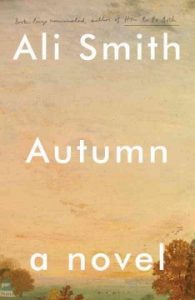 Autumn: From celebrated author Ali Smith comes the first in a proposed “seasonal quartet”—four stand-alone books, separate yet interconnected and cyclical (as the seasons, after all, are)–that will consider what it means to live in a specific time and place, as well as what it means to live at all. At the heart of this story is the relationship between Daniel, a 100-year-old man, and his neighbor Elizabeth, born in 1984. We see these two together at different stages of Elizabeth’s life, from her childhood to the present day, and, through them, get a look at the world that is forming around them, and shaping their everyday existence. Smith dived headfirst into the anguish, turmoil, and anger that is fueling our world today, and uses her characters as a lens through which to mourn, to contemplate, and, perhaps, to offer a little bit of hope for an honest human connection in the midst of….all of this. It’s not an easy book to explain, but it’s an enormously significant one, and a gutsy move from an author who has never been afraid to push the proverbial envelope. This book, which is being hailed as the first ‘post-Brexit’ novel to engage with the Brexit debate, is making waves on both sides of the pond, with The Guardian calling it “a beautiful, poignant symphony of memories, dreams, and transient realities; the ‘endless sad fragility’ of mortal lives.”
Autumn: From celebrated author Ali Smith comes the first in a proposed “seasonal quartet”—four stand-alone books, separate yet interconnected and cyclical (as the seasons, after all, are)–that will consider what it means to live in a specific time and place, as well as what it means to live at all. At the heart of this story is the relationship between Daniel, a 100-year-old man, and his neighbor Elizabeth, born in 1984. We see these two together at different stages of Elizabeth’s life, from her childhood to the present day, and, through them, get a look at the world that is forming around them, and shaping their everyday existence. Smith dived headfirst into the anguish, turmoil, and anger that is fueling our world today, and uses her characters as a lens through which to mourn, to contemplate, and, perhaps, to offer a little bit of hope for an honest human connection in the midst of….all of this. It’s not an easy book to explain, but it’s an enormously significant one, and a gutsy move from an author who has never been afraid to push the proverbial envelope. This book, which is being hailed as the first ‘post-Brexit’ novel to engage with the Brexit debate, is making waves on both sides of the pond, with The Guardian calling it “a beautiful, poignant symphony of memories, dreams, and transient realities; the ‘endless sad fragility’ of mortal lives.”
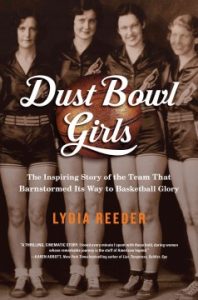 Dust Bowl Girls: At the height of the Great Depression, with dust storms ravaging the mid-west, and financial hardship touching–or ruining–over a third of the US population, Sam Babb, the charismatic basketball coach of tiny Oklahoma Presbyterian College, began dreaming. He traveled from farm to farm across hundreds of miles, offering young women a free college education if they would play for his newly-formed basketball team, the Cardinals. While these women were remarkable simply for taking the risk of leaving their home and pursuing a dream that would daunt many, they also accomplished something remarkable as a deeply-devoted team: they won every game they played. In this beautifully-told and thoroughly-researched history, Sam Babb’s granddaughter, Lydia Ellen Reeder tells about the Cardinals, their rise to athletic dominance, and their showdown with the reigning champions of basketball (a team led by none other than Babe Didrikson). Though a story, ultimately, of triumph, she also discusses the intense scrutiny, suspicion, and condemnation to which these women were subjected, and the prevailing myths and lies that they also defeated in the course of their remarkable athletic careers. Library Journal gave this book a big nod, noting that it is “Equal parts social history and sports legend come to life . . . Of special interest for students of women’s studies and a strong contender for a film adaptation. With high appeal to sports fans and historians, this hidden gem of a story deserves a place in all public library collections.”
Dust Bowl Girls: At the height of the Great Depression, with dust storms ravaging the mid-west, and financial hardship touching–or ruining–over a third of the US population, Sam Babb, the charismatic basketball coach of tiny Oklahoma Presbyterian College, began dreaming. He traveled from farm to farm across hundreds of miles, offering young women a free college education if they would play for his newly-formed basketball team, the Cardinals. While these women were remarkable simply for taking the risk of leaving their home and pursuing a dream that would daunt many, they also accomplished something remarkable as a deeply-devoted team: they won every game they played. In this beautifully-told and thoroughly-researched history, Sam Babb’s granddaughter, Lydia Ellen Reeder tells about the Cardinals, their rise to athletic dominance, and their showdown with the reigning champions of basketball (a team led by none other than Babe Didrikson). Though a story, ultimately, of triumph, she also discusses the intense scrutiny, suspicion, and condemnation to which these women were subjected, and the prevailing myths and lies that they also defeated in the course of their remarkable athletic careers. Library Journal gave this book a big nod, noting that it is “Equal parts social history and sports legend come to life . . . Of special interest for students of women’s studies and a strong contender for a film adaptation. With high appeal to sports fans and historians, this hidden gem of a story deserves a place in all public library collections.”
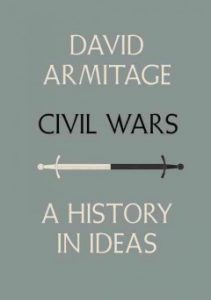 Civil Wars: A History in Ideas: “Civil War” is a concept that, I would argue, most of us think we understand. But in this fascinating little tome, historian David Armitage walks his audience through the many, many forms that civil wars can take, and just what the consequences are for labeling a conflict as such–for example, the potential for any other powers engaging, profiting from, or controlling the outcome of one. From the American Revolution to the current-day way in Iraq, and journeying via philosophy, economics, biography, and history, Armitage’s book considers wars on the ground, as well as the theory of war itself, arguing that, no matter how many times we try to end wars, violence seems to be an inherent part of the nation-state system, and our best defense is to understand how and why specific forms of violence occur. Publisher’s Weekly gave this book a starred review, and called this work “Learned…Indispensable…a model of its kind: concise, winningly written, clearly laid out, trenchantly argued…His conclusion is sobering: human societies may never be without this kind of conflict, and we’re better off trying to understand it than ignoring its problematic nature. It’s hard to imagine a more timely work for today.”
Civil Wars: A History in Ideas: “Civil War” is a concept that, I would argue, most of us think we understand. But in this fascinating little tome, historian David Armitage walks his audience through the many, many forms that civil wars can take, and just what the consequences are for labeling a conflict as such–for example, the potential for any other powers engaging, profiting from, or controlling the outcome of one. From the American Revolution to the current-day way in Iraq, and journeying via philosophy, economics, biography, and history, Armitage’s book considers wars on the ground, as well as the theory of war itself, arguing that, no matter how many times we try to end wars, violence seems to be an inherent part of the nation-state system, and our best defense is to understand how and why specific forms of violence occur. Publisher’s Weekly gave this book a starred review, and called this work “Learned…Indispensable…a model of its kind: concise, winningly written, clearly laid out, trenchantly argued…His conclusion is sobering: human societies may never be without this kind of conflict, and we’re better off trying to understand it than ignoring its problematic nature. It’s hard to imagine a more timely work for today.”
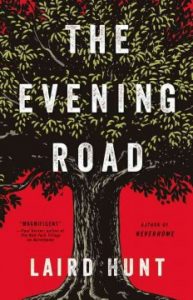 The Evening Road: Another historical fiction piece set in a small town, and another that is receiving critical acclaim from a number of outlets. At its heart is Ottie Lee Henshaw and Calla Destry, two determined women whose lives have been shaped by prejudice and violence, who meet by chance one dark day in the 1920’s. Ottie Lee, her husband, and her lecherous boss are traveling to a planned lynching, and pick up Calla, who has been waiting for a meeting that never happened. Though infused with violence, bigotry, and sheer human horror, the real power of this novel comes from the tiny moments of intimacy–shared, appreciated, or otherwise–that define these relationships, and the depth of character with which Laird Hunt infuses each of his characters. This is a challenging read, not only because of its structure, but because of the realities it forces readers to face, but for those very same reasons, it’s an important one, and most definitely one that will linger for long after it’s been finished. Kirkus Reviews agrees, saying in their starred review “Hunt finds history or the big events useful framing devices, but he is more interested in how words can do justice to single players and life’s fraught moments. Hunt brings to mind Flannery O’Connor’s grotesques and Barry Hannah’s bracingly inventive prose and cranks. He is strange, challenging, and a joy to read.”
The Evening Road: Another historical fiction piece set in a small town, and another that is receiving critical acclaim from a number of outlets. At its heart is Ottie Lee Henshaw and Calla Destry, two determined women whose lives have been shaped by prejudice and violence, who meet by chance one dark day in the 1920’s. Ottie Lee, her husband, and her lecherous boss are traveling to a planned lynching, and pick up Calla, who has been waiting for a meeting that never happened. Though infused with violence, bigotry, and sheer human horror, the real power of this novel comes from the tiny moments of intimacy–shared, appreciated, or otherwise–that define these relationships, and the depth of character with which Laird Hunt infuses each of his characters. This is a challenging read, not only because of its structure, but because of the realities it forces readers to face, but for those very same reasons, it’s an important one, and most definitely one that will linger for long after it’s been finished. Kirkus Reviews agrees, saying in their starred review “Hunt finds history or the big events useful framing devices, but he is more interested in how words can do justice to single players and life’s fraught moments. Hunt brings to mind Flannery O’Connor’s grotesques and Barry Hannah’s bracingly inventive prose and cranks. He is strange, challenging, and a joy to read.”
